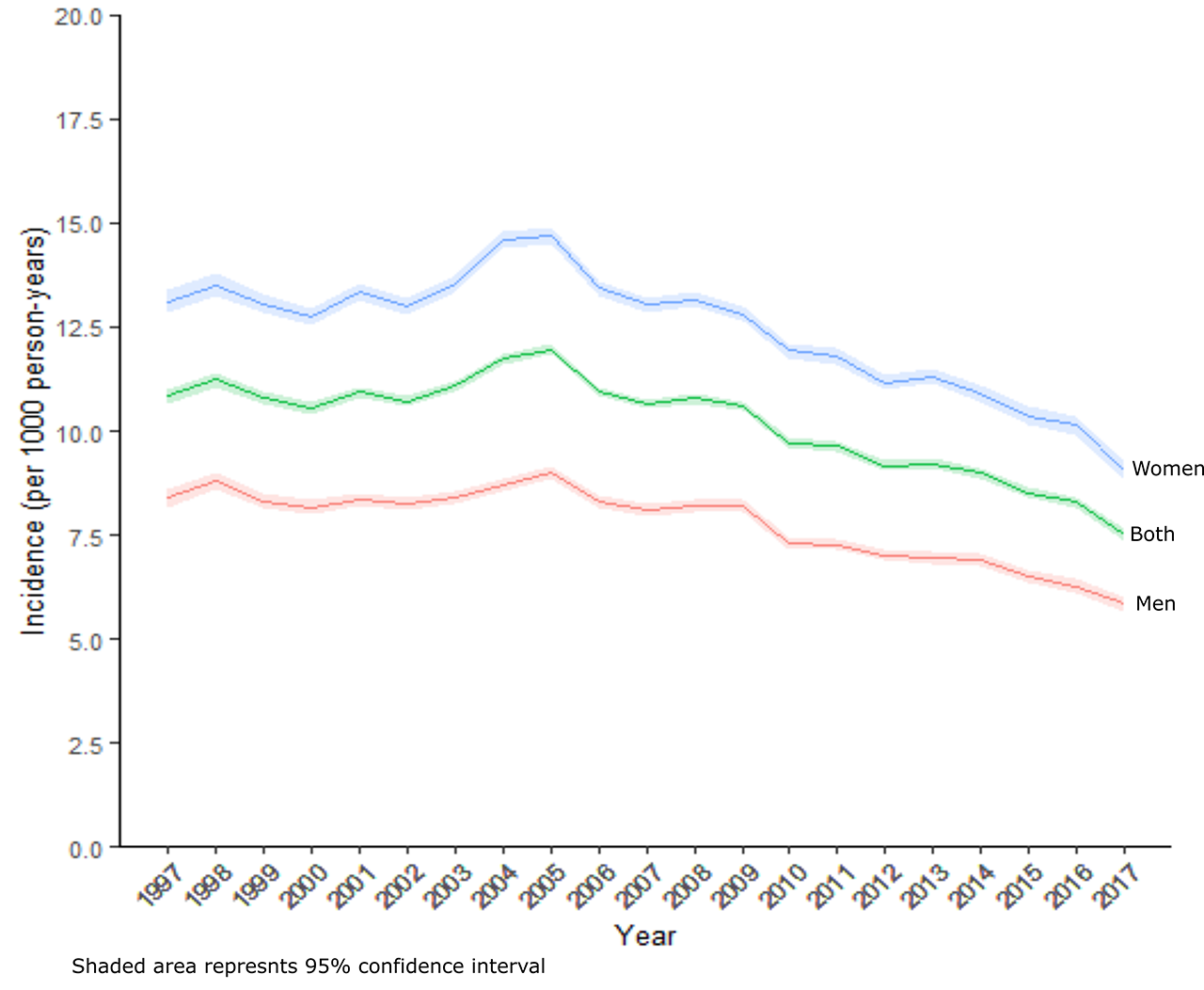Session Information
Date: Sunday, November 10, 2019
Title: 3S074: Epidemiology & Public Health I: Risk Factors & Outcomes for Rheumatic Diseases (821–826)
Session Type: ACR Abstract Session
Session Time: 2:30PM-4:00PM
Background/Purpose: Osteoarthritis (OA) is by far the most common arthritis.(1) However, its chronological trend in the United Kingdom (UK) is not known. We aimed to explore the trend in both incidence and prevalence of OA among adults aged 20 years or more in the UK during the period 1997-2017 using a large nationally representative primary care database.
Methods: The UK Clinical Practice Research Datalink (CPRD), comprising data on 17 million patients, was used for this study (2). We estimated the incidence and prevalence of general practitioner (GP) diagnosed OA (both overall and joint-specific: hip, knee, ankle/foot, wrist/hand and unspecified site) which was age-sex standardized using 2017 UK mid-year population. Joinpoint analysis was performed to identify the trend points. Geographical distribution was mapped according to the different regions in the UK. The data used for the study is recorded by the GPs in UK, and nearly 100% patients would have met the ACR classification criteria.
Results: During the year 1997-2017, 608,350 incident OA cases aged >20 years were recorded. In 2017, the standardized prevalence of GP-diagnosed OA for any joint in both sexes was 10.44% (95% CI 10.39%-10.49%), 12.49%; 95% CI 12.41%-12.56%) in women and 8.28% (95%CI 8.22%-8.35%) in men. The prevalence recorded according to body site was unspecified joint (7.32%), knee (2.76%), hip (1.17%), wrist/hand (0.52%) and foot/ankle (0.29%). The prevalence of any-OA increased from 4.9% in 1997 to 10.4% in 2017 with average annual percentage increase of 3.9% (95% CI 3.5-4.2%). (Figure-1) The standardised incidence of any OA in both sexes in 2017 was 7.5 per 1000 person-years (95% CI 7.4-7.6 per 1000 person-years), 9.0 per 1000 person-years (95% CI 8.8-9.2 per 1000 person-years) in women and 5.8 per 1000 person-years (95% CI 5.7-6.0 per 1000 person-years) in men. In 2017, the incidence recorded in joints was: unspecified site OA (5.2 per 1000 person-years), followed by knee (2.3 per 1000 person-years), hip (1.1 per 1000 person-years), wrist/hand (0.68 per 1000 person-years) and foot/ankle (0.19 per 1000 person-years) OA. The incidence of any OA decreased from 10.8 per 1000 person-years (95% CI 10.7-11.0 per 1000 person-years) in 1997 to 7.5 per 1000 person-years (95% CI 7.4-7.6 1000 person-years) in 2017 with an average annual percentage reduction of -1.7% (95%CI -2.6 to -0.8). (Figure-2) The prevalence and incidence varied across the UK, with the northern region had higher OA prevalence and incidence compared to the rest of the UK in 2014 with few exceptions. (Figure-3)
Conclusion: In the UK approximately one in 10 adults have clinically diagnosed OA. The knee is the commonest recorded site for OA that results in GP consultation. While the prevalence has increased, incidence has decreased in this population in the past 20 years. Further research is needed to understand these changes.
Reference:
- Litwic A, Edwards MH, Dennison EM, Cooper C. Epidemiology and burden of osteoarthritis. Br Med Bull. 2013;105:185-99.
- Herrett E, Gallagher AM, Bhaskaran K, Forbes H, Mathur R, van Staa T, et al. Data Resource Profile: Clinical Practice Research Datalink (CPRD). Int J Epidemiol. 2015;44(3):827-36.
For men and women- Age standardized; Both- Age and sex standardized
For men and women- Age standardized; Both- Age and sex standardized
The contribution from East Midlands region to the CPRD-GOLD database used in the study was nearly zero, which did not allow to have whole country representation for the year 2017.
To cite this abstract in AMA style:
Swain S, Sarmanova A, Mallen C, Kuo C, Coupland C, Zhang W. Trends in Incidence and Prevalence of Osteoarthritis in the United Kingdom: Findings from the Clinical Practice Research Datalink (CPRD) [abstract]. Arthritis Rheumatol. 2019; 71 (suppl 10). https://acrabstracts.org/abstract/trends-in-incidence-and-prevalence-of-osteoarthritis-in-the-united-kingdom-findings-from-the-clinical-practice-research-datalink-cprd/. Accessed .« Back to 2019 ACR/ARP Annual Meeting
ACR Meeting Abstracts - https://acrabstracts.org/abstract/trends-in-incidence-and-prevalence-of-osteoarthritis-in-the-united-kingdom-findings-from-the-clinical-practice-research-datalink-cprd/



